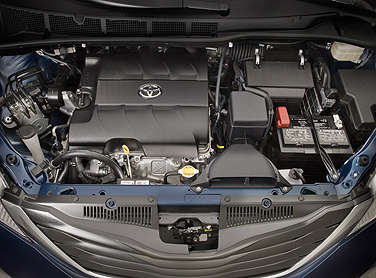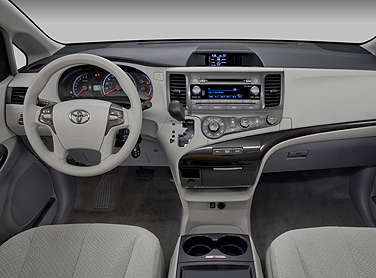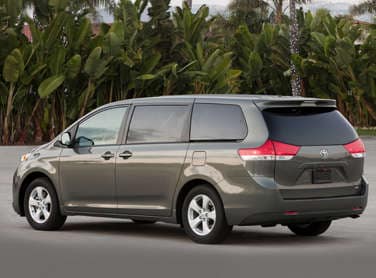Recent Articles
Popular Makes
Body Types
Krome on Cars on the 2011 Toyota Sienna

I got some further insight into the state of the minivan revolution recently, courtesy of a weeklong test drive of the 2011 Toyota Sienna, and the results were quite surprising. There was actually a fair amount of swagger in Toyota's "Swagger Wagon," certainly enough to kick-start the moribund minivan segment, but that obviously hasn't happened—so let's explore some of the reasons why.
(Toyota, of course, provided me with the Sienna and a full tank of gas.)
A Fuel-Economy Fail?
As some folks may recall, I had been predicting a resurgence in minivan sales this year based on a couple of different factors, including the continuing migration of customers away from big SUVs due to the rising price of gasoline. It's true that minivans haven't exactly been known as fuel sippers, but with three all-new models debuting in the space of a few months, and two more getting heavily revised, I was hoping for wholesale improvements across the board. In the end, however, the increases were generally more modest—or non-existent.
The EPA lines for the previous-generation Japanese minivans were Nissan Quest, 16 mpg city/24 mpg highway/19 mpg combined; Honda Odyssey, 16/23/18; and Toyota Sienna, 17/23/19. The all-new versions run as follows: Quest, 19/24/21; Odyssey, 19/28/22; and Sienna, 19/24/21. The Chrysler Group thoroughly refreshed its Dodge Grand Caravan and Chrysler Town & Country, even to the point of adding an all-new V6, but that didn't help the vehicles' fuel efficiency, which remained unchanged at 17/25/20. The sixth minivan on the market, the Kia Sedona, has received less in the way of changes, but they've brought more in the way of improved fuel economy, as the vehicle has moved from a line of 17/23/19 for 2010 to 18/25/21.
Now, it's hard to find a lot of fault with Honda, which turned the rankings on their head by moving the Odyssey from the bottom of the minivan fuel-efficiency list to the top, with increases of at least 19 percent in each part of the EPA testing regime. But something clearly went wrong somewhere with the Sienna, because its relatively minor efficiency improvement came despite a major change in its powertrain, as the vehicle is now available with an I4—but that engine's only advantage over the V6 is a 1 mpg boost to city mileage.
The Quest gets the exact same highway rating it did two years ago, and the Chrysler Group's entire Pentastar strategy strikes me as out of step with the times, as that engine is simply not tuned with fuel efficiency as a focus in any of its applications. Even Kia's half-hearted efforts to keep the Sedona relevant have been more effective at improving fuel economy.

Thinking Outside the Box
The other key part of my prediction for minivan success had to do with a concerted effort on the part of Honda, Nissan and Toyota to add some design flair to their minivan offerings, and here all three were more effective. Honda's lightning-bolt design on the Odyssey, the Sienna's aggressive front end and the Quest's Sienna/Ford Flex mash-up are all highly distinctive, even if the Toyota and the Nissan both appear to have gone to the same surgeon for nose jobs. Even the Chrysler products have managed to get somewhat better looking; at this stage, only the Sedona retains a softer, more traditional minivan-type appearance.
My experience with the Sienna also shows that, at least for Toyota, much effort was made to improve the driving experience as well. The vehicle has notably dynamic handling and a surprising amount of power, and although the result isn't the most well-sorted vehicle I've ever driven, it's vastly more interesting to drive than older minivans. And the truth is, I turned up better than 20 mpg in a week during which I explored the limits of said handling and power quite often.
There were plenty of nits worth picking—including overly hard seats and some hard-to-reach controls—but Toyota did an admirable job helping the Sienna overcome both its and its segment's reputation for boredom. That, along with some rather extensive incentives from Toyota earlier in the year, helped the vehicle get off to a very strong start in 2011. Through the first five months of the year, the Sienna's sales results went as follows: +145.7 percent, +118.3 percent, +29.4 percent, +27 percent and -12.5 percent.
Yes, those numbers are going in the wrong direction, but the Sienna's triple-digit jumps in January and February were unsustainable and patently connected to Toyota's discount efforts. And last month, production shortages, real and perceived kept a lid on Sienna sales the same way they did on products from all of the Japanese automakers. A growth rate in the upper 20s/lower 30s seems about right to me, and that would be an impressive feat for the minivan.

Sales to Rise this Fall?
In fact, I'm impressed enough with the Sienna that I'm not going to back down on my call for a minivan renaissance, merely postpone it. My thinking: In addition to being all-new, relatively stylish and at least somewhat more fuel efficient, I'll point to the last similarity I mentioned above as the chief reason the segment hasn't increased sales like I thought it would. Which means when Japanese production comes back later this year, so should minivan momentum.
